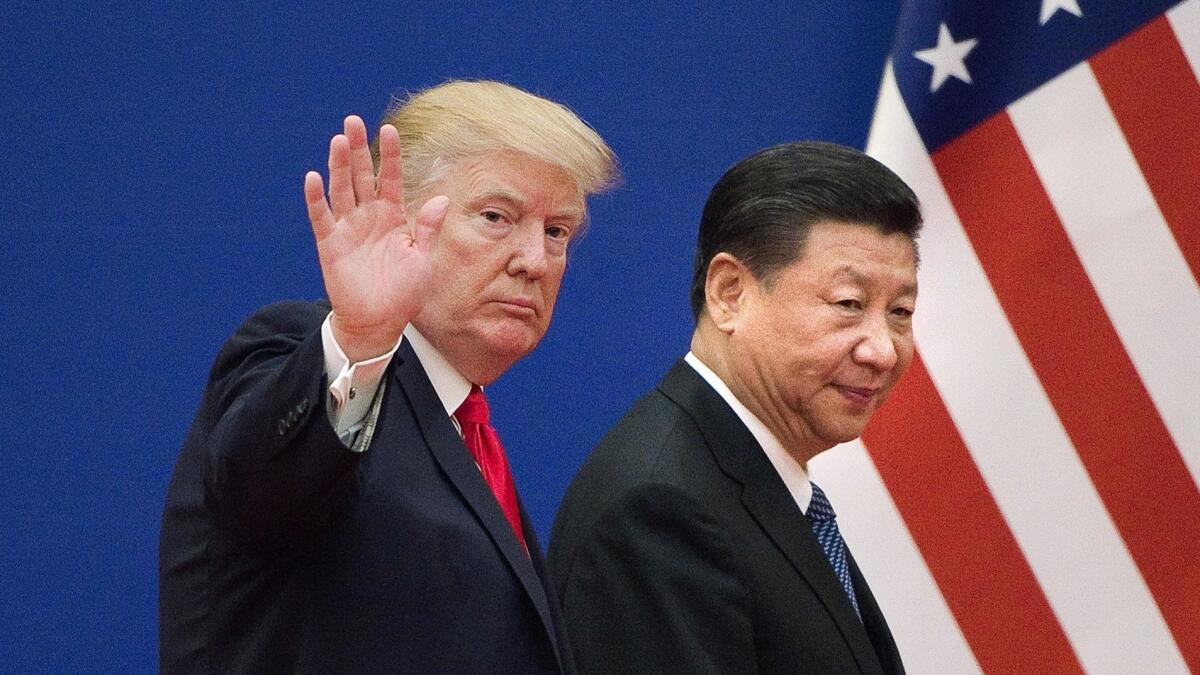Column: Trump’s trade war is politically motivated, yet hurts consumers and GOP voters, study shows

- Share via
The economic rationale for President Trump’s trade war with China has been so threadbare and the likelihood of losses so great that no one should be surprised that it hasn’t been the success Trump predicted.
But the nature of its failure hasn’t been quantified, until now. In a newly released study draft, a team of economists find that U.S. consumers have paid the entire price for Trump’s tariffs. Producers in America’s agricultural heartland — largely Republican — have been especially hammered.
“Workers in very Republican counties,” they write, “bore the brunt of the costs of [the] trade war.” Those in Democratic-leaning counties, meanwhile, “ended up experiencing relative gains (that is, experienced the smallest losses.)”
This return to protection is unprecedented in the post-war era.
— Fajgelbaum et al.
The authors, Pablo D. Fajgelbaum of UCLA, Pinelopi K. Goldberg of Yale and the World Bank (where she is chief economist), Patrick J. Kennedy of UC Berkeley and Amit K. Khandelwal of Columbia, pegged the annual economic loss from Trump’s tariffs at $68.8 billion, or about 0.37% of gross domestic product, chiefly because of higher-cost imports. Gains to some domestic producers who benefited from protective tariffs cut the overall loss to $6.4 billion, or .03% of GDP.
But in the authors’ eyes, the distributional impact is more important. Put simply, a few manufacturing sectors gained — “Think steel tariffs,” Kennedy wrote on Twitter — but agricultural producers lost. “Think soybean tariffs,” he added.
In their paper, titled “The Return to Protectionism,” the authors observed that “this return to protection is unprecedented in the post-war era due to the sizes of the countries involved, the magnitude of the tariff increases, and the breadth of tariffs across sectors.”
Yet as many trade experts have observed, the Trump administration launched its trade war based on fundamental misunderstandings of how international trade works, little consistency in applying tariffs to products or sectors, and little consideration of how the trade war would affect the economy.
Experts have been especially critical about the administration’s fixation on trade deficits with certain countries, notably China. This is almost certainly the handiwork of Trump trade advisor Peter Navarro of UC Irvine, whose work shows an obsession with ostensible unfair trade practices by China.
The focus on bilateral trade imbalances is “misguided,” Caroline Freund of the World Bank wrote in 2017. “Singling out individual countries according to bilateral deficits may be of political use because we often interact with individual countries, but it does not make economic sense.”
Bilateral trade imbalances are typically structural — arising from the nature of each country’s economies — not the result of unfair trade practices, she observed. The U.S. has a large trade deficit with Germany and a trade surplus with the Netherlands, she noted, even though they have identical trade practices. But “Germany makes a lot of goods Americans want, like cars and machinery, while Americans make a lot of goods the Netherlands wants, like medical equipment and pharmaceuticals.”
More generally, economists reckoned that the trade war would be a drag on U.S. economic growth. A March 2018 poll by the University of Chicago of a panel of 43 leading economists from across the ideological spectrum on whether the first round of tariffs on steel and aluminum would “improve Americans’ welfare” found that 93% disagreed or strongly disagreed. None agreed, and three panelists didn’t answer.
Trump launched his trade war in 2018, eventually increasing tariffs on 12,000 products, including solar panels, aluminum and steel. The biggest target was China, which produces 11,173 of the targeted goods, accounting for nearly $247 billion of the $303 billion in imports subject to new or increased tariffs.
China, Mexico, the European Union and Canada, among other countries, responded with retaliatory tariffs on $96 billion in U.S. exports.
The economists’ data indicate that Trump’s choices of tariff targets were politically motivated: They appear to be aimed to stimulate the Republican vote in swing counties. “Counties with a 40-60% Republican vote share received more protection than heavily Republican or Democratic counties,” they found. “Hence, U.S. tariffs appear targeted towards politically competitive counties, where voters are not overwhelmingly Republican or Democrat.”
Retaliatory tariffs imposed by target countries, especially China, have been much more precisely aimed. They’ve been designed to hit Trump’s political base the hardest, and they’ve succeeded.
The regions in which the benefits of the protective tariffs were concentrated were the Midwestern Great Lakes and the industrial Northeast, which might gain as tariffs on imported steel shifted manufacturers to domestic sources.
But the retaliation was aimed at the American farmer. U.S. soybean purchases by China, the world’s largest buyer, fell to zero in November. The soybean trade had been worth $12 billion to American growers in 2017. The Trump administration has promised to make up the losses to farmers with $12 billion in aid, but not all of that has been disbursed.
More generally, the economists’ paper shows that the Trump tariffs have been entirely passed through to U.S. consumers. That’s because foreign exporters haven’t moderated the impact of the U.S. tariffs by cutting prices.
Keep up to date with Michael Hiltzik. Follow @hiltzikm on Twitter, see his Facebook page, or email [email protected].
Return to Michael Hiltzik’s blog.
More to Read
Get the L.A. Times Politics newsletter
Deeply reported insights into legislation, politics and policy from Sacramento, Washington and beyond. In your inbox twice per week.
You may occasionally receive promotional content from the Los Angeles Times.











